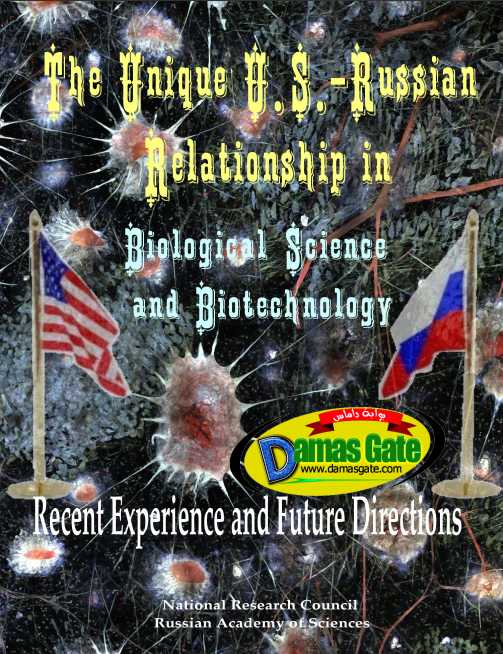THE UNIQUE U.S.-RUSSIAN RELATIONSHIP IN BIOLOGICAL
SCIENCE AND BIOTECHNOLOGY: RECENT EXPERIENCE AND FUTURE
DIRECTIONS

INTRODUCTION
In the fall of 2010, the U.S. National Academies (consisting of the National Academy of Sciences, the National Academy of Engineering, and the Institute of Medicine) and the Russian Academy of Sciences, in cooperation with the Russian Academy of Medical Sciences and the Russian Academy of Agricultural Sciences, established a joint committee of 12 prominent scientists from the United States and Russia to review past and current U.S.-Russian bioengagement activities and to propose future directions for cooperation that will serve the interests of both countries. (See Appendix A.1 for biographies of committee members.) The U.S. Department of State and the Russian Academy of Sciences supported the committee’s efforts.
The Statement of Task that the committee addressed is as follows:
The committee will carry out an assessment of U.S.-Russian bioengagement activities during the past 15 years, with particular attention to the impacts of various types of engagement activities, lessons learned from engagement activities that are relevant for future U.S.Russian engagement
programs, and future approaches to U.S.-Russian bioengagement, particularly approaches that
build on the foundations for cooperation that have been established during recent years.
Context for the Report
For decades, many Russian and American organizations and individual scientists have
recognized the importance of working together on a bilateral basis in the biological sciences and biotechnology (hereinafter collectively referred to as bioengagement). Often they have developed and carried out programs within the frameworks of formal intergovernmental agreements. At other times, they have conducted joint activities under a variety of less formal arrangements, ranging from handshakes between individual scientific leaders to institution-toinstitution memoranda of understanding.
Download
*
SCIENCE AND BIOTECHNOLOGY: RECENT EXPERIENCE AND FUTURE
DIRECTIONS

INTRODUCTION
In the fall of 2010, the U.S. National Academies (consisting of the National Academy of Sciences, the National Academy of Engineering, and the Institute of Medicine) and the Russian Academy of Sciences, in cooperation with the Russian Academy of Medical Sciences and the Russian Academy of Agricultural Sciences, established a joint committee of 12 prominent scientists from the United States and Russia to review past and current U.S.-Russian bioengagement activities and to propose future directions for cooperation that will serve the interests of both countries. (See Appendix A.1 for biographies of committee members.) The U.S. Department of State and the Russian Academy of Sciences supported the committee’s efforts.
The Statement of Task that the committee addressed is as follows:
The committee will carry out an assessment of U.S.-Russian bioengagement activities during the past 15 years, with particular attention to the impacts of various types of engagement activities, lessons learned from engagement activities that are relevant for future U.S.Russian engagement
programs, and future approaches to U.S.-Russian bioengagement, particularly approaches that
build on the foundations for cooperation that have been established during recent years.
Context for the Report
For decades, many Russian and American organizations and individual scientists have
recognized the importance of working together on a bilateral basis in the biological sciences and biotechnology (hereinafter collectively referred to as bioengagement). Often they have developed and carried out programs within the frameworks of formal intergovernmental agreements. At other times, they have conducted joint activities under a variety of less formal arrangements, ranging from handshakes between individual scientific leaders to institution-toinstitution memoranda of understanding.
Download
*